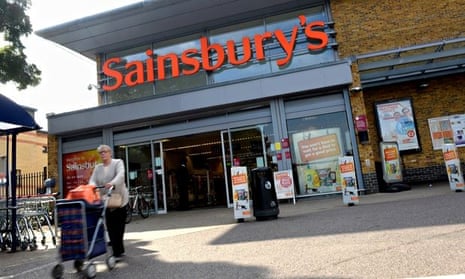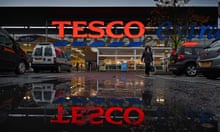Sainsbury’s has slumped into the red after taking a one-off charge of £628m to pull out of building 40 new supermarkets and downgrading the value of 40 underperforming stores, just a year after writing off plans for 15 new supermarkets at a cost of £92m.
The supermarket group dived to a loss of £290m in the six months to the end of September but began its fightback against the discount chains and bigger rivals with plans for £150m of price cuts and improvements to the quality of 3,000 products.
Sainsbury’s admitted there was under-utilised space in a quarter of its stores and said it would reorganise them to sell more clothes and homewares or put in concessions such as travel money and phone shops. It has already been testing Timpson and Jessops concessions.
As it took its boldest step yet into an industry price war which former chief executive Justin King last year dismissed as a “skirmish”, Sainsbury’s warned it would cut its dividend to shareholders, cut costs and slash capital spending by half to ensure it could compete.
Mike Coupe, who took over as chief executive in July, said: “We have put the building blocks in place to make sure we have set this business up for the future and made some quite tough decisions … to make sure we have the cash resources to deal with whatever comes our way.”
In a reference to Tesco, which is expected to take more action on prices under new chief executive Dave Lewis, Coupe added: “We are very aware somebody is limbering up in the changing room and that market dynamics can change, and part of today is about making sure we are on the front foot.”
Coupe warned that underlying sales for all the major supermarkets were likely to continue falling for the next 18 months to two years.
“The next 18 months to two years will be very challenging. I don’t anticipate the current environment will change that much,” he said.
The company said underlying profits would be lower in the second half of the year than that achieved in the first.
Sales at established Sainsbury’s stores dropped 2.1% in the half-year. Excluding one-off charges, underlying pre-tax profit dropped 6.3% to £375m, slightly ahead of the City’s expectations.
Dave McCarthy, an analyst at HSBC, said: “We now expect profits to fall this year and next, before levelling off in 2017-18. But it could get worse, depending on what Tesco does next ...
“Management produced a strategic review which reflects the perilous state of the industry. The future offers falling profits as industry dynamics bite deeper, falling returns as operationally geared supermarkets continue to lose sales and diminishing dividends as they track falling profits.”
The company is aiming to cut costs by £500m over the next three years. On top of that it aims to save £50m this year and £150m a year for the next three years by getting better deals from suppliers. It slashed capital spending by almost half to between £500m and £550m a year over the three-year period, but stuck to its target of opening 100 convenience stores a year. It still plans to open eight supermarkets over the next two years, and a further four to replace old stores. Analysts suggested its full-year dividend could fall by as much as a quarter.
Half the £150m of price cuts to lure shoppers back from Aldi and Lidl will come by March. Most will be on commodity items such as nappies and toilet roll. It will also invest in improving the quality of 3,000 items by adding more meat to ready meals, for example, or lengthening the shelf life of strawberries with new packaging.
Discounters’ Christmas
More than half of British shoppers will visit discounters including Aldi, Lidl and Iceland to buy their Christmas supplies this year as they try to rein in spending.
Spending on food, presents and decorations is expected to rise 2.7% to £16bn but more than a fifth of shoppers are planning to spend less than they did last year, according to research by ecommerce company Webloyalty.
A third of shoppers said they would visit Aldi and Lidl, but a bigger proportion, 40%, will shop at Tesco which remains the chain where most people in the UK plan to buy at least some of their festive groceries despite its recent troubles. Nearly 30%will visit up-market stores including M&S, Tesco and Waitrose.
A third of the 2,000 shoppers questioned by market research firm Conlumino for Webloyalty said they would buy their Christmas food solely online.






Comments (…)
Sign in or create your Guardian account to join the discussion